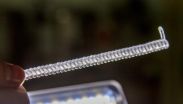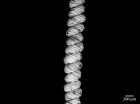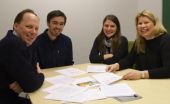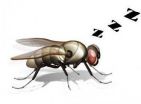(Press-News.org) An international team led by The University of Texas at Dallas has discovered that ordinary fishing line and sewing thread can be cheaply converted to powerful artificial muscles.
The new muscles can lift a hundred times more weight and generate a hundred times higher mechanical power than the same length and weight of human muscle. Per weight, they can generate 7.1 horsepower per kilogram, about the same mechanical power as a jet engine.
In a paper published Feb. 21 in the journal Science, researchers explain that the powerful muscles are produced by twisting and coiling high-strength polymer fishing line and sewing thread. Scientists at UT Dallas's Alan G. MacDiarmid NanoTech Institute teamed with scientists from universities in Australia, South Korea, Canada, Turkey and China to accomplish the advances.
The muscles are powered thermally by temperature changes, which can be produced electrically, by the absorption of light or by the chemical reaction of fuels. Twisting the polymer fiber converts it to a torsional muscle that can spin a heavy rotor to more than 10,000 revolutions per minute. Subsequent additional twisting, so that the polymer fiber coils like a heavily twisted rubber band, produces a muscle that dramatically contracts along its length when heated, and returns to its initial length when cooled. If coiling is in a different twist direction than the initial polymer fiber twist, the muscles instead expand when heated.
Compared to natural muscles, which contract by only about 20 percent, these new muscles can contract by about 50 percent of their length. The muscle strokes also are reversible for millions of cycles as the muscles contract and expand under heavy mechanical loads.
"The application opportunities for these polymer muscles are vast," said corresponding author Dr. Ray Baughman, the Robert A. Welch Distinguished Chair in Chemistry at UT Dallas and director of the NanoTech Institute. "Today's most advanced humanoid robots, prosthetic limbs and wearable exoskeletons are limited by motors and hydraulic systems, whose size and weight restrict dexterity, force generation and work capability."
Baughman said the muscles could be used for applications where superhuman strengths are sought, such as robots and exoskeletons. Twisting together a bundle of polyethylene fishing lines, whose total diameter is only about 10 times larger than a human hair, produces a coiled polymer muscle that can lift 16 pounds. Operated in parallel, similar to how natural muscles are configured, a hundred of these polymer muscles could lift about 0.8 tons, Baughman said.
On the opposite extreme, independently operated coiled polymer muscles having a diameter less than a human hair could bring life-like facial expressions to humanoid companion robots for the elderly and dexterous capabilities for minimally invasive robotic microsurgery. Also, they could power miniature "laboratories on a chip," as well as devices for communicating the sense of touch from sensors on a remote robotic hand to a human hand.
The polymer muscles are normally electrically powered by resistive heating using the metal coating on commercially available sewing thread or by using metal wires that are twisted together with the muscle. For other applications, however, the muscles can be self-powered by environmental temperature changes, said Carter Haines, lead author of the study.
"We have woven textiles from the polymer muscles whose pores reversibly open and close with changes in temperature. This offers the future possibility of comfort-adjusting clothing," said Haines, who started his research career in Baughman's lab as a high school student doing summer research through the NanoExplorers program, which Baughman initiated. Haines earned an undergraduate physics degree from UT Dallas and is now a doctoral student in materials science and engineering.
The research team also has demonstrated the feasibility of using environmentally powered muscles to automatically open and close the windows of greenhouses or buildings in response to ambient temperature changes, thereby eliminating the need for electricity or noisy and costly motors.
INFORMATION:
Other UT Dallas Nanotech Institute researchers involved with the work are Dr. Shaoli Fang, associate research professor; Dr. Marcio Lima and Dr. Mikhail Kozlov, research scientists; Dr. Na Li, Dr. Mônica Jung de Andrade, Dr. Jiyoung Oh and Dr. Xavier Lépro, research associates; and Benjamin Swedlove, graduate research assistant.
International collaborators are Dr. Geoffrey M. Spinks, Dr. Javad Foroughi, Sina Naficy and Dr. Gordon G. Wallace from the University of Wollongong (Australia); Dr. Fatma Göktepe and Dr. Özer Göktepe from Namik Kemal University (Turkey); Shi Hyeong Kim and Dr. Seon Jeong Kim from Hanyang University (Korea); Seyed M. Mirvakili and Dr. John D. W. Madden from the University of British Columbia (Canada); and Xiuru Xu from Jilin University (China).
The research was principally funded by the Air Force Office of Scientific Research, with additional funding from the Air Force, the Office of Naval Research, the Robert A. Welch Foundation, the Creative Research Initiative Center for Bio-Artificial Muscle, the Korea-U.S. Air Force Cooperation Program, the Australian Research Council, the Australian National Fabrication Facility, a Canada Discovery grant, the China National 973 Project and NSF China.
UT Dallas-led team makes powerful muscles from fishing line and sewing thread
2014-02-20
ELSE PRESS RELEASES FROM THIS DATE:
Bioengineered growth factors lead to better wound healing
2014-02-20
When we are wounded, our bodies naturally begin a process of repair of the damaged tissue. This process is mediated by biological molecules called growth factors, which are proteins that occur naturally in our cells and guide processes ranging from embryonic development to healing. Given their regenerative role in the body, growth factors have been investigated for use in drugs but with limited success. Publishing in Science, an EPFL group has used bioengineering to significantly improve the efficacy of clinical growth factors in the context of soft tissue and bone repair, ...
Previous rapid thinning of Pine Island Glacier sheds light on future Antarctic ice loss
2014-02-20
New research, published this week in Science, suggests that the largest single contributor to global sea level rise, a glacier of the West Antarctic Ice Sheet, may continue thinning for decades to come. Geologists from the UK, USA and Germany found that Pine Island Glacier (PIG), which is rapidly accelerating, thinning and retreating, has thinned rapidly before. The team say their findings demonstrate the potential for current ice loss to continue for several decades yet.
Their findings reveal that 8000 years ago the glacier thinned as fast as it has in recent decades, ...
Scientists create powerful artificial muscle with fishing line
2014-02-20
Researchers are using fibres from fishing line and sewing thread to create inexpensive artificial muscles that could be used in medical devices, humanoid robots, prosthetic limbs, or woven into fabrics.
In a study published today in Science, international researchers, including University of British Columbia Electrical and Computer Engineering professor John Madden and PhD candidate Seyed Mohammad Mirvakili, detail how they created inexpensive artificial muscles that generate far more force and power than human or animal muscles of the same size.
"In terms of the strength ...
Unstable Atlantic deep ocean circulation under future climate conditions
2014-02-20
Today, deep waters formed in the northern North Atlantic fill approximately half of the deep ocean globally. In the process, this impacts on the circum-Atlantic climate, regional sea level, and soak up much of the excess atmospheric carbon dioxide from industrialisation — helping to moderate the effects of global warming. Changes in this circulation mode are considered a potential tipping point in future climate change that could have widespread and long-lasting impacts including on regional sea level, the intensity and pacing of Sahel droughts, and the pattern and rate ...
Sequencing hundreds of nuclear genes in the sunflower family now possible
2014-02-20
Advances in DNA sequencing technologies have enormous potential for the plant sciences. With genome-scale data sets obtained from these new technologies, researchers are able to greatly improve our understanding of evolutionary relationships, which are key to applications including plant breeding and physiology.
Studies of evolutionary (or phylogenetic) relationships among different plant species have traditionally relied on analyses of a limited number of genes, mostly from the chloroplast genome. Such studies often fail to fully or accurately resolve phylogenetic ...
Study shows that premature infants benefit from adult talk
2014-02-20
Research led by a team at Women & Infants Hospital of Rhode Island and The Warren Alpert Medical School of Brown University has been published in the February 10, 2014 online edition of Pediatrics, the official journal of the American Academy of Pediatrics. The research indicates that premature babies benefit from being exposed to adult talk as early as possible.
The research, entitled "Adult Talk in the NICU (neonatal intensive care unit) with Preterm Infants and Developmental Outcomes," was led by Betty Vohr, MD, director of Women & Infants' Neonatal Follow-Up Program ...
GW researcher finds gene therapy a promising tool for cardiac regeneration
2014-02-20
WASHINGTON (Feb. 20, 2014) — After a heart attack, there is often permanent damage to a portion of the heart. This happens, in part, because cardiac muscle cells are terminally differentiated and cannot proliferate after blood flow is blocked off to the heart. This partial healing can be attributed to heart disease being one of the leading causes of death. What if the cells could be stimulated to divide and the heart could be induced to repair itself? This was the question posed by George Washington University (GW) researcher Scott Shapiro, M.D., Ph.D., and his co-authors, ...
Active thyroid may raise risk of depression in older individuals
2014-02-20
Chevy Chase, MD—When older individuals' thyroid glands are more active than average, it may be a risk factor for depression, according to new research accepted for publication in the Endocrine Society's Journal of Clinical Endocrinology & Metabolism (JCEM).
Beyond its role in regulating the body's metabolism, the thyroid gland also can influence mental health. Past research has found links between an increased risk of depression and both over- and underactive thyroid glands. This study is the first to find an association between depression and thyroid activity variations ...
Stress hormone linked to frailty
2014-02-20
Chevy Chase, MD—Lower morning and higher evening cortisol levels contribute to frailty in older individuals, according to new research accepted for publication in the Endocrine Society's Journal of Clinical Endocrinology & Metabolism (JCEM).
Frailty confers a high risk for institutionalization and increased risk of mortality and is characterized by unintentional weight loss, feelings of exhaustion and fatigue, physical inactivity, slow gait speed and low grip strength. Neuroendocrine function, including cortisol secretion, is thought to be involved in the etiology of ...
Study in fruitflies strengthens connection among protein misfolding, sleep loss, and age
2014-02-20
PHILADELPHIA - Pulling an "all-nighter" before a big test is practically a rite of passage in college. Usually, it's no problem: You stay up all night, take the test, and then crash, rapidly catching up on lost sleep. But as we age, sleep patterns change, and our ability to recoup lost sleep diminishes.
Researchers at the Perelman School of Medicine, University of Pennsylvania, have been studying the molecular mechanisms underpinning sleep. Now they report that the pathways of aging and sleep intersect at the circuitry of a cellular stress response pathway, and that ...




